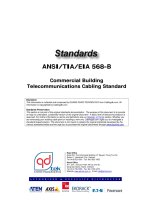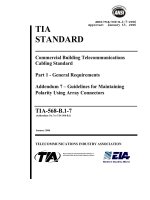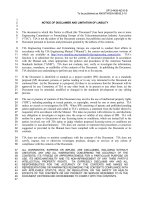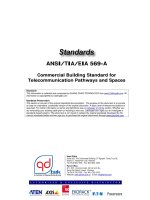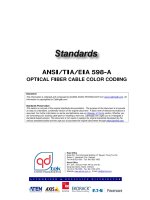Tài liệu Cabling Standard - TIA 598 A - FO Cable Color Coding doc
Bạn đang xem bản rút gọn của tài liệu. Xem và tải ngay bản đầy đủ của tài liệu tại đây (237.73 KB, 8 trang )
ANSI/TIA/EIA 598-A
OPTICAL FIBER CABLE COLOR CODING
Disclaimer
This information is collected and composed by QUANG DUNG TECHNOLOGY from www.Cablingdb.com. All
information is copyrighted by Cablingdb.com.
Standards Preservation
This section is not part of the original standards documentation. The purpose of this document is to provide
an easy to understand, condensed version of the original document. A basic level of telecommunications is
assumed. For further information on terms and definitions see our Glossary of Terms section. Whether you
are renovating your existing cable plant or installing a new one, Cablingdb.com urges you to investigate a
standards based solution. This document is not meant to replace the original standards developed by the
various standards bodies and we urge you to purchase the original documents through www.tiaonline.com.
AUT HORIZED & EXCLUSIVE DISTRIBUTOR
Head Office
Suite 202, The Colonnade Building, 27 Nguyen Trung Truc St.,
District 1, Hochiminh City, Vietnam
Tel: 84.8 823-1693 Fax: 84.8 823-1665
Hanoi Office
A11, 3/Fl., Horizon Hotel, 40 Cat Linh St.,
Dong Da District, Hanoi, Vietnam
Tel: 84.4 736-7055 Fax: 84.4 733-2470
Website: www.qd-tek.com.vn
Email:
ANSI/TIA/EIA 598-A Optical Fiber Cable Color Coding
Quang Dung Technology Distribution Company Page 2 of 8
Table of Contents
INTRODUCTION
CABLE TYPES
Distribution Cable
Interconnect Cables and Cords
Breakout Cables
COLOR CODING SCHEME
Binder Groups
Tracers
Continuous Intermittent Longitudinal and Spiral Tracers
Continuous, Intermittent Ring Stripe and Hash Tracers
COLOR CODING OF OPTICAL PREMISES CABLE
Premise Breakout Cable
Color Control, Limits and Permanency
SUMMARY
ANSI/TIA/EIA 598-A Optical Fiber Cable Color Coding
Quang Dung Technology Distribution Company Page 3 of 8
The goal of this standard is to provide a uniform identification process for fiber optic
cable by color coding the individual fibers and the jacket. The standard applies to
premise and outside plant fiber for both long and short haul applications. While the
original documentation is focused at the manufacturer, installation and design
organizations should be familiar with the color coding scheme of the individual fibers
for termination purposes.
When terminating fiber optic cable, each fiber is assigned a numerical position in
relation to the termination box positions, beginning with the number one. Each color
of fiber then has a corresponding position number that it is associated with.
Optical premise cable:
• is intended primarily for indoor use
• shall meet the appropriate National Electrical Code requirements for particular
installations (plenum cable, riser cable, or general purpose cable, as
applicable), and other mechanical and/or environmental requirements as
specified for the intended applications
• may be suitable for limited outdoor applications if constructed for that
application
• normally consists of one or more fibers of specified fiber sizes, coated or
uncoated and buffered to an appropriate specified diameter.
CABLE TYPES
Distribution Cable
Distribution cable normally consists of two or more fibers bundled together in units
and is generally used to distribute signals within a building.
Interconnect Cable or Cord
An Interconnect Cable or Interconnect Cord consists of one or two fibers, reinforced
and jacketed, and is intended for short distance applications such as intra-equipment
jumpers or patch cords.
A single fiber cable is referred to as a simplex cable, and a two-fiber cable is called
duplex cable. A duplex cable consists of two simplex cables or two individual fibers
assembled with an overall jacket, or two simplex cables bonded together. A dual fiber
cable which can be separated into two individual cables by "tearing" them apart is
also referred to as a "zip cord".
Breakout Cable
Premises Breakout Cable is made up of two or more stand alone sub-cables
assembled together under a common outer jacket so that each sub-cable can be
separated from the main cable for routing to, and termination at, various locations.
These cables have a larger overall diameter than normal premise cabling because of
the size of the sub cables.
ANSI/TIA/EIA 598-A Optical Fiber Cable Color Coding
Quang Dung Technology Distribution Company Page 4 of 8
Cable Construction
Premise Cable
Interconnect Cable
ANSI/TIA/EIA 598-A Optical Fiber Cable Color Coding
Quang Dung Technology Distribution Company Page 5 of 8
Breakout Cable
COLOR CODING SCHEME
When multiple fibers are housed in a single buffer tube, the color coding of the fiber
optic cables enables the installer/administrator to easily identify the individual fibers.
This color scheme may also be used, but is not mandatory for fibers that are
identified by their position; eg: ribbon fiber.
When a number of fibers (e.g., 6, 12, 18, 24) form a unit/bundle, and units/bundles
are grouped to form groups, the units and groups shall be uniquely identified and
shall also follow the color scheme shown in the Fiber Optic Cable Color Code
chart.
Fiber Color Identification Chart
Position
Number
Color & Tracer
1
Blue
2
Orange
3
Green
4
Brown
5
Slate
6
White
7
Red
8
Black
9
Yellow
10
Violet
11
Rose
12
Aqua
13
Blue with Black Tracer
14
Orange with Black Tracer
